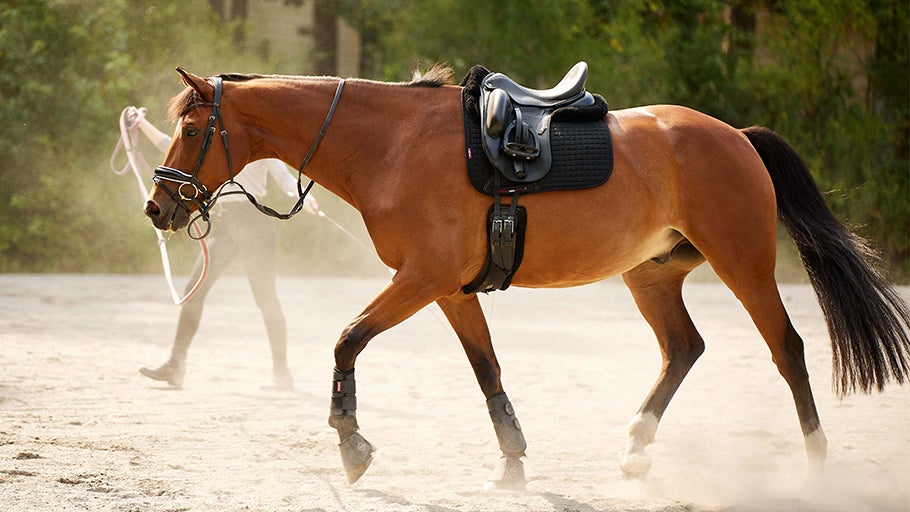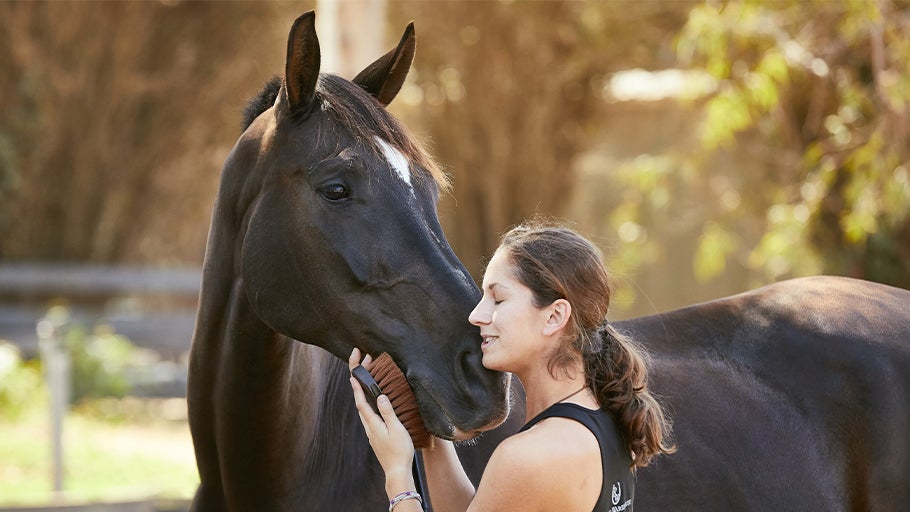
Lunging a Horse Safely: Training & Equipment Guide
Lunging a horse safely is a skill every equestrian should know, as it can be used to start a young horse, provide training and exercise for a more experienced horse, or even diagnose a lameness. The correct lunging technique is important so that you can get the most benefits from the exercise while keeping you and your horse safe. In this article and video, we will discuss the equipment needed to lunge and how to use it, as well as aids you can employ for effective communication with your horse.
Lunging Equipment
When lunging, there is a basic set of equipment you'll need for you and your horse. The tack needed can vary based on whether you're lunging in preparation for riding, or lunging as the sole activity. As the rider, you will always need to be wearing closed-toe shoes and gloves; and a helmet is also recommended. A lunge line and lunge whip will also be needed. For the horse, you will need a bridle, headstall, or cavesson to attach the lunge line to. When lunging with a bridle, it is important to use one with a snaffle bit only. You do not want to lunge in any bit that multiplies pressure or manipulates pressure.
A saddle or surcingle is useful if you are planning to ride after or use side reins and other training aids. If you do choose to lunge with a saddle, it is important to make sure your stirrups don't become loose as you lunge. Either remove them or crisscross them in front of the pommel. If you have a western saddle, they can remain loose.
For the bridle or headstall, make sure the reins are either removed or tied up. To tie up the reins, take the right and left rein and twist them together a few times. Then take the throatlatch and put it through one of the loops you have made and buckle it a little looser than you normally would. It is also recommended to put boots and bell boots on your horse to protect them from interference.
Attaching the Lunge Line to the Bit
There are quite a few ways of attaching the lunge line to the bit. We will show you two recommended ways that apply equal pressure to both sides of the bit. The first way provides a bit more control since it creates a gag motion and provides poll pressure. You take your lunge line through the inside ring of the bit, up over the poll (making sure the line is flat and not twisted), then clip it to the outside ring with the buckle facing into the horse (pictured below).
Another way to attach the lunge line is to run the line through the inside ring, loop it around the bottom of the inside ring, and then run the line under the chin and clip it to the outside ring with the clip facing into the horse (pictured below). This provides contact on the inside for direct pressure, but also feeling on the outside to help keep the horse straighter.
If you have a lunging attachment on your bridle, you can clip the lunge line directly onto that. If you choose to use a lunging cavesson, you can clip the lunge line directly to the center ring on the nose.
Holding the Lunge Line
After you've attached the lunge line, you need to know how you should hold it. The best way to hold the excess line is to have it looped back and forth across the palm. This will prevent the line from binding around your hand in case the horse spooks or runs off, and instead it slides out of your hand. The excess line can be held in the hand connected to your horse, or in your whip hand. We recommend holding the excess line in your whip hand because it gives you two points of contact, making it safer and more organized.
To hold the lunge line, you can either hold it like you would reins (coming in through the bottom of your hand and the excess coming out the top with your thumb on top) or how you would hold driving reins (coming in at the top with the excess coming out the bottom of your hand). Many people find that holding it as you would reins gives them more control, and they are able to keep their arm more engaged.
How to Lunge the Horse
Now that you have all your equipment, you can find a place to lunge your horse. A round pen is always ideal, as it gives you a natural circle and contains your horse if they get loose. However, a round pen isn't always available, so lunging in an open space is good practice. Find an area that is flat with no obstacles that will interfere with you or your horse; ideally penned, in case your horse gets away from you. Make sure you have at least 30 feet of space to lunge, so you can adjust the size of the circle your horse makes.
Position yourself in the middle of the circle. Keep yourself in the center by pivoting on your heel instead of moving around or following your horse. Imagine that you are standing in a hula-hoop on the ground and try to stay within that space, this way the circle says centered around you. The goal is for the horse to make accurate circles without falling in or out. There may be some situations where you must move but try to return to pivoting after you have made your adjustments. If you happen to be working with a young or inexperienced horse, you may walk a small circle to encourage them to move forward. However, once they understand the forward pressure, work toward pivoting.
Lunging Aids
The Lunge Line as an Aid:
The lunge line is our physical connection with the horse and acts like the "rein." Make sure that it does not go slack and drag on the ground, which is a hazard for both horse and rider. The line should feel like a bungee cord, meaning you should neither feel constant pressure nor a lack of pressure. Think about having a connection where you can make a correction if needed, then release once the horse responds.
Using the Whip as an Aid:
The whip is a substitute for the "rider's leg" and should be accepted by the horse as an aid, and not a reason to run away. You can use the whip as pressure to move forward, to move out on the circle, or even to stop. Position-wise, you should form a triangle with the horse, the lunge line, and the whip; meaning you are one point of the triangle, and the head and tail of the horse are the other two points. To ask your horse to move forward, raise the whip up and position it toward their hindquarters. If the horse does not move forward, then swish the lash up and down without cracking it for more encouragement. If you need even more encouragement, flick the lash toward the horse's hocks. To have the horse move out on the circle, position the lunge whip toward their shoulder and ask them to move out with your voice. You can use the term "out" in conjunction with the whip. The whip can even be used to ask the horse to slow down by pointing the whip in front of them, stepping toward them, and using your voice. Please note that you should only perform this technique with an experienced horse or one who understands the necessary aids.
Using Your Voice and Body as an Aid:
The last aid is your voice and body, which works with both the whip and the lunge line. Your voice can ask the horse to walk, trot, canter, halt, and move forward or slow down in their gait. To do this, pick the terms you would like to use with your horse and keep to them. This way your horse will always receive the same commands. You can also use your voice to encourage the horse to move forward in the gait they are in. For example, "clucking" in conjunction with using the lunge whip asks a horse to take longer steps in the trot. When asking the horse to move from a slower gait to a faster gait—for example, from walking to trotting—animate your voice higher when giving the command. You can use this higher tone command with your lunge whip to ask your horse to move to an upward gait. To bring your horse back to a slower gait, animate your voice to a lower, more drawn-out tone when you say the command (potatohhhhh same as woahhhhh). To use your body, you can walk slightly with the horse to encourage forward movement and visa versa to stop. You may need to use your lunge line with your voice and body to bring them down a gait.
Frequently Asked Questions
What is lunging a horse?
Lunging is the act of having a horse move around in a circle around the rider for either exercise or to judge the soundness of the horse. The circle can vary in size depending on the space provided or the length of the lunge line. Riders often lunge horses in softer sand; however, when judging the soundness of a horse, a vet may want to see the horse move on soft and hard ground.
What is the purpose of lunging a horse?
Riders lunge horses for a few reasons. Exercise is the most popular reason for lunging. Lunging is typically used to either let the horse get out some energy before riding or in conjunction with training equipment (like side reins) to encourage the horse to carry itself properly. As discussed above, lunging can be used to diagnose lameness as horses may show greater discomfort on a circle. Lunging can even be beneficial for riders as they can take "lunge" lessons to work on a particular skill without having to control the horse.
How do you lunge a stubborn horse?
Stubbornness in horses can come from a few sources, such as fear, pain, leaving their comfort area, and lack of respect. We suggest working with a professional, like a trainer or a vet, to address this issue.
How long should I lunge my horse?
Most horses don't need to be lunged longer than 25 minutes, so prepare accordingly. Take time to offer walk breaks and switch sides every 5 to 10 minutes. This will give your horse an even warm-up and good practice lunging to the left and right.
How to lunge a horse without getting dizzy?
If you become dizzy while lunging, we suggest two methods to help you. Try walking in small circles while lunging instead of staying centered in the middle. Another way to fight dizzyness is to focus on a part of your horse, such as the shoulder or hip, while you are lunging. This point of focus should help keep you from feeling dizzy.
Closing Thoughts
Horse lunging can be beneficial for young to experienced horses, as well as riders themselves! As with most equestrian activities, we stress safety so you can enjoy your favorite equine without becoming harmed. Wearing protective boots, gloves to prevent rope burn, and even a helmet are a great way to ensure you are protected in the event your horse becomes a bit "wild." If you ever experience any trouble with lunging, we suggest consulting with a trainer who can be on the ground to help you. As always, if you have questions, feel free to contact our friendly customer service at info@ridingwarehouse.com or by calling 1(800)620-9145. Happy riding (and lunging)!
Ready to start lunging, yet in need of equipment? Check out the link below to shop lunge lines, training equipment, and more!
Related Articles














